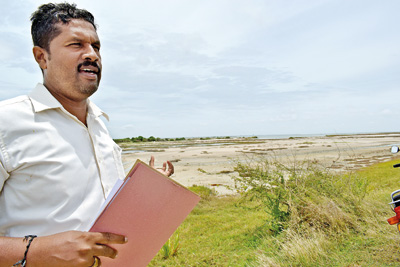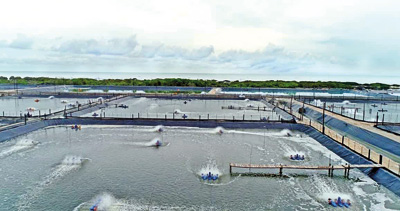News
Traditional prawn cultivators in north fear troubled waters ahead
While preparations to facilitate a private venture to breed an imported crustacean named Vannamei, or white leg shrimp in artificial ponds have been continuing for months, little has been communicated to area fishermen who fear a blow to their livelihoods

Annalingam Annarasa at the site of the proposed prawn farm
At the pristine Arali Point in the Jaffna Peninsula, a storm is gathering over a prawn farm.
Fishermen who have for centuries harvested these crustaceans in the Jaffna lagoon are alarmed by a plan to breed an imported species named Vannamei, or white leg shrimp, in artificial ponds spread over 150 acres on the border of the Velanai and Kayts divisions. Both are islands–desolately breathtaking and heavily depopulated by war and lack of opportunity.
Why, then, is “development” so stridently opposed by inhabitants? Because they worry that the environmental repercussions of the project will be so severe that it will wipe out their traditional livelihoods.
“We do a lot of sea-based prawn farming in this area,” said Annalingam Annarasa, the 42-year-old leader of the Jaffna Fisheries Federation representing 119 fishing societies. “The creation of an artificial prawn farm can create problems for us.”
Fishermen also fear that the farm will cull the demand for natural prawn and shrimp. Mr Annarasa has voiced his concern to the authorities after fishermen heard “through various sources” of the project. The lack of transparency and consultation has heightened their apprehension, particularly as they have seen how prawn farming in places like Puttalam wrecked the ecology of the lagoons.
In 2016, the Government even suspended the issuing of permits to businesses in that district citing “poor farming practices”. Weak regulation facilitated the spread of bacteria and highly contagious viruses such as white spotted disease, mainly through improper discharge of water used in the farms.
An estimated 3,000 households in ten villages are dependent on this section of the lagoon, mainly for its supply of prawn and shrimp, Mr Annarasa said: “When they cultivate prawns here, it will impact the environment and affect our catch. Diseases will spread to the lagoon. And the natural breeding grounds of the prawns and fish will be destroyed.”
Armed with a file containing project documents and all the appeals he has made, Mr Annarasa gestured towards the lagoon, visible across a sand flat earmarked for the prawn farm. There is untouched beauty here—migratory birds, seagrass and rich aquatic life.
It is unsurprising that families are anguished by the impending changes. There was a similar project in the Mannar district, they said. But, while fishermen there had also protested, it went ahead on private land.
“We are not against development,” Mr Annarasa insisted. “But why not produce crabs or fish or even sea cucumber? We have been catching prawns here for generations, as long as I can remember. This area is ecologically sensitive.”
Fisher unions are so uneasy that they approached researchers at the Zoology Department of the Jaffna University for assistance. There are sustainable ways of building prawn farms but the fear is that private sector developers are too mercenary to install the necessary safeguards as these will drive up the project cost, said Prof (Mrs) R Gnaneswaran of the Zoology Department. A team is gathering data on the lagoon to present to the Fisheries Minister and also plans to hand over a blueprint for a sustainable method to farm prawn.
“This is essential,” she stressed, “but everywhere, whether it be in Viddataltivu or Puttalam, nobody is concerned about the environment. We must not rule out development of this nature. However, if we protest against one method, we must also provide an alternative.”
Thulasita William, a Senior Lecturer at the same Department, is leading the research into the possible impact of prawn farming on the relevant area. “It will be a problem because the ecosystem in the lagoon supports breeding and growing of natural prawn,” she said. “It can be disturbed, not just by building ponds close-by but through effluent discharge and road construction.”

In spite of protests a similar project is in opeartion in Mannar.(Pic courtesy NAQDA)
Fishermen have traditionally used closely-set stake nets to catch white prawn and red prawn, Dr William said. These are not ideal for the environment either but have been practised for decades. According to her interviews, supply has been abundant year around. The lagoon is also teeming with fish. The coastal area has sponge. While there are only a few patches of mangroves, seagrasses are aplenty.
“This is the first time prawn farming is proposed for the area,” Dr William continued. “Will the company obey rules and regulations strictly? That is the question. If they do, then it’s ok. But if they pollute the area, there will be a big issue. Effluents from the farm may also affect the natural food balance in the lagoon and habitat destruction will drive fish and birds away.”
There are also concerns of groundwater salinization through seepage from tanks, Dr William said. But the National Aquaculture Development Authority (NAQDA) insisted that all bases have been covered.
A spokesman also said that the process is still at the stage of land release and this, too, will involve all offices including the Divisional Secretariat, Coast Conservation Department (CCD), Marine Environment Protection Authority (MEPA), Central Environmental Authority (CEA), Pradeshiya Sabya, Fisheries Department and NAQDA.
The project proposal seen by the Sunday Times was so badly written that it raised more questions than it answered. It alluded more to the prawn market in the United States (with chunks cut and pasted from other sources). But once the land is allocated, the company—a Jaffna-based seafood processor and collector named Annai Seafood (Pvt) Ltd—will have to submit a detailed report on the farming component, said Nirooparaj Balachandran, NAQDA Assistant Director for the Northern Province.
This will be a ‘closed system recirculating farm with bio-membranes’, similar to one built in Mannar, Mr Balachandran elaborated. Meetings have now been promised to fishermen to explain the technology. The resistance to development is normal. But statistics show that natural harvest from the lagoon is declining, he claimed. And traditional fisheries is also destructive.
Being land-based, the farm will not affect seagrass. And there are no mangroves there. Aquatic organisms like carnivorous fish, filter feeders, milkfish, sea cucumber and various species of seaweed will be used for biological treatment of effluent.
The farm will be nothing like the structures in Puttalam. This discharge will only go into the lagoon if there is intensive rain of between 100 and 200mm. And this will be permitted under MEPA, CEA and CCD supervision. While the developer wanted 300 acres of land, only 150 will be released, Mr Balachandran said, admitting that they have been “unable to educate the fishermen in their lingo”.
“Our licensing process is annually renewable so if there is a drop in implementation standards, they will be rejected until they adhere to them,” Mr Balachandran said. “The public can also monitor and raise their concerns. NAQDA has already developed best management practices that are compulsory for all farms. And for exports, they will be subject to European Union audits, and so on.”
But while preparations to facilitate this venture has been continuing for months, none of this has been explained to the villagers of the area who are despondent over possible challenges to their own income. Questions still remain over effluent discharge—whether it will be practised as strictly as it is promised—and there does not appear to have been an independent scientific eye cast over the project proposal as described by NAQDA.
Until these gaps are addressed, the fishing communities of Kayts and Velanai will continue to lose sleep.

